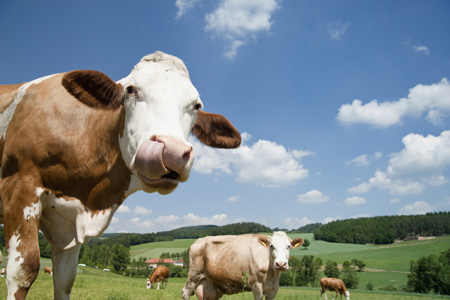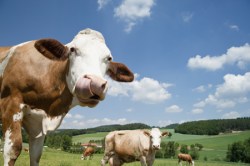Bartlett Durand is the rare local-food entrepreneur who has no trouble turning a profit: Durand’s Black Earth Meats processes and sells grass-fed beef, and these days grass-fed beef sells like crazy.
Located near Madison, Wis., Black Earth is an abattoir, an old-fashioned butchery containing everything from a slaughterhouse to a retail store. Its sales have doubled in four out of the last five years. Durand expects them to jump again this year, from $6 million to $10 million. Orders have poured in so swiftly that, in addition to artisan butchers, Black Earth had to hire a “chef liaison” to translate orders into cow anatomy.
“Chefs have been trained in the box beef codes and don’t always know where the meat comes from on the animal,” Durand explains. “A chef will say, ‘I want a filet de round.’ My butcher will say, ‘What the hell is that?’”
Grass-fed beef, like “filet de round,” is a concept that eludes people outside the beef industry. So a little background is in order.
In the months after birth, a calf drinks the rich milk of its mother. Once weaned, it might be lucky enough to follow mom around the pasture for a little while, munching grass — but sooner or later, it is customarily sent to a feedlot to be fattened on grain, a process somewhat like tossing an animal on a full-tilt assembly line. Cows left to fatten in the field are the ones that become “grass-fed beef.” They gain the same weight, but more slowly, taking up to 14 months more, and yield a leaner beef. Some farmers of grass-fed beef are purists and leave the cow in the pasture till the day it dies. Others “cheat” by giving the cow a month or two of grain at the end, but in the comfort of the barnyard, not a 10,000-head feedlot. Durand sells both kinds.
Durand is a trim 45-year-old who has deep roots in agriculture. His grandfather was a geographer who studied milksheds. “I was a vegetarian in college because of how meat was raised and handled,” Durand recalls. When he married into a farm family, he started helping out and ultimately quit his job as a lawyer to pursue food full time.
In the $79-billion beef industry, his company is miniscule. Four giant companies control 80 percent of the beef market. “A really big kill for us would be 50 cows in one day,” says Durand. “A small packinghouse processes 1,500 to 3,000 a day.”
Yet his business has the customers to grow. Black Earth buys cows from 78 farmers. To keep up with demand, Durand must convince them to raise more cows on grass alone. He must also lure new farmers to the field. And farmers, though intrigued, are justifiably wary. Is grass-fed beef a fad among chefs and yuppies destined to peter out, or a major new market?
Folks like Durand are betting on the latter. They believe that grass-fed beef — which cuts out both feedlots and the resource-intensive practice of raising grain just to feed cows — can catalyze a great change in American agriculture.
As Fred Kirschenmann, a sustainable farmer and noted agricultural scholar, says: “Putting cattle back on pasture will be the beginning of more resilient, less energy-intensive farming systems that are more likely to survive in our future of higher energy costs, unstable climates, and depleted fresh water and mineral resources.”
Risky business
Because of the farmer’s extra time and investment, grass-fed beef is intrinsically more expensive than feedlot beef. That extra cost gets passed along to consumers. In my neighborhood supermarket, I found conventional round steak on offer for $5.49 a pound. The same cut of steak from Black Earth went for $13 a pound.
Such premium prices represent an economic opportunity for farmers, but only if they survive a risky transition to what remains a rarified, niche market. Tom Martin of Mountain Lane Farm in Wauzeka, Wis., switched to grass-feeding in 2001. More than a decade later, he is still learning its finer points. He has a herd of 125 cows and sells his beef at farmers markets and out of his home freezer.
For Martin, both farming and marketing grass-fed beef have proven difficult. “It’s a work in progress and a learning process,” he explains. “With grass-feeding, there’s a lot of science, but there’s some art to it, too.” For instance, grass-fed farmers must learn to “listen” for the cows to tell them when it’s time to rotate to a fresh pasture.
“Not knowing where the next check is coming from is a little dicey,” he continues. “It’s been a struggle to make the relationships. I feel like locally, people still look at the price and say, ‘That’s too much.’”
Greener pastures
Like other farmers I talked to, Martin made this economic gamble in part because he values the environmental benefits of grass-feeding.
Grazing pastures provide habitat for lots of creatures, not just cows, from big bluestem to prairie chickens. When managed properly, they can store carbon [PDF] in much the same way that a forest does. Finishing cows on the range eliminates the need for concentrated animal feeding operations, or CAFOs, which sully water quality from little creeks all the way down the Mississippi River and into the Gulf of Mexico.
Moreover, a well-managed, ecologically diverse rangeland holds up in drought conditions, according to Greg Judy, a farmer who grass-feeds 300 cows in Rucker, Mo. “We’re going to have enough grass in the fields to graze all winter long,” he says, “even though we had no rain for 130 days this past summer.”
Some folks will protest that the U.S. lacks the land area to switch the beef industry to grass-finishing. While there’s some truth in this critique, it misses the larger point: The beef industry and American agriculture as a whole have a lot to gain from rethinking their approach to land use, according to Fred Kirschenmann.
“We have to remember that raising animals in confinement means we have to raise lots of corn and soybeans to feed them,” says Kirschenmann. “A lot of that land could be used for grazing on perennials and raising alfalfa for forages, which would have significant ecological benefits.”
To hear some apostles of grass tell it, though, grass-fed beef begins and ends with taste. Todd Churchill, a farmer who owns Thousand Hills Cattle Company in Cannon Falls, Minn., and dresses like an extra from The Magnificent Seven, is emphatic on this point. “All the intellectual arguments about grass-fed beef, animal welfare, and environmental impacts — those are great stories, and they’re true. But the only purpose they serve is to get someone to try our product for the first time.”
“This is about producing an eating experience that is so incredible that people will pay more for it,” Churchill says.
But by that logic, even the most immaculately cultivated grass-fed steak becomes an all-or-nothing taste-test that hordes of Americans will fail because they grew up on the uniform, greasy taste of feedlot burgers.
The cows that become those burgers taste the same because, from one feedlot to another, they eat the same thing: industrial feed made from grains and soy. On the other hand, the grasses on rangeland can vary quite a bit, making grass-fed beef much more heterogeneous and thus something of an acquired taste.
“Some people will say it tastes a little gamey,” says Durand. “You may get an occasional wild flavor in there, a little extra flavor. This is what beef was prior to 1960. Once people understand that’s what it tastes like, they love it.”
Beefing up production
No one keeps reliable statistics on the production of the grass-fed beef. One agricultural consultant estimates that in 2009, grass-fed netted $380 million — or 0.005 percent of the total U.S. beef industry.
The hot sales of grass-fed have piqued the interest of cash-starved farmers. Cheap corn is part of what makes feedlots so profitable, and right now, because of the drought, corn prices are sky high. As Churchill notes, “I’ve had several farmers in the last month call and say, ‘I’m tired of losing $100 a head putting my cattle in a feedlot. Tell me about your model.’”
Farmers are drawn to small, boutique beef companies like Thousand Hills or Black Earth because of their established brand and clients. Yet they must make significant changes in their operations for the partnership to succeed.
Black Earth, for instance, refers prospective farmers to an agricultural consultant to help them through the transition. The consultant may recommend fortifying pastures with native grasses, reducing the herd size, adopting new grazing patterns, moving fences, or all of the above.
Durand offers tutorials as needed. “We had a farmer come in who had been growing conventional steers with corn,” he recalls. “He brought us his first grass-fed steers, and they were poor quality. He took them out of the pasture too early. We had to really work with him on different types of forage crops he could grow for the cows. It takes a farmer who will listen and respond.”
“They have to think differently,” says Greg Judy. “There has to be some education teaching them how to stockpile forages and plan through a drought. There’s a lot of management to it.”
Farmers are expert managers — but as such, they tend to eschew big risks. And this is the conundrum that haunts the grass-fed beef industry: Do farmers believe in grass-fed enough to bet the farm?




